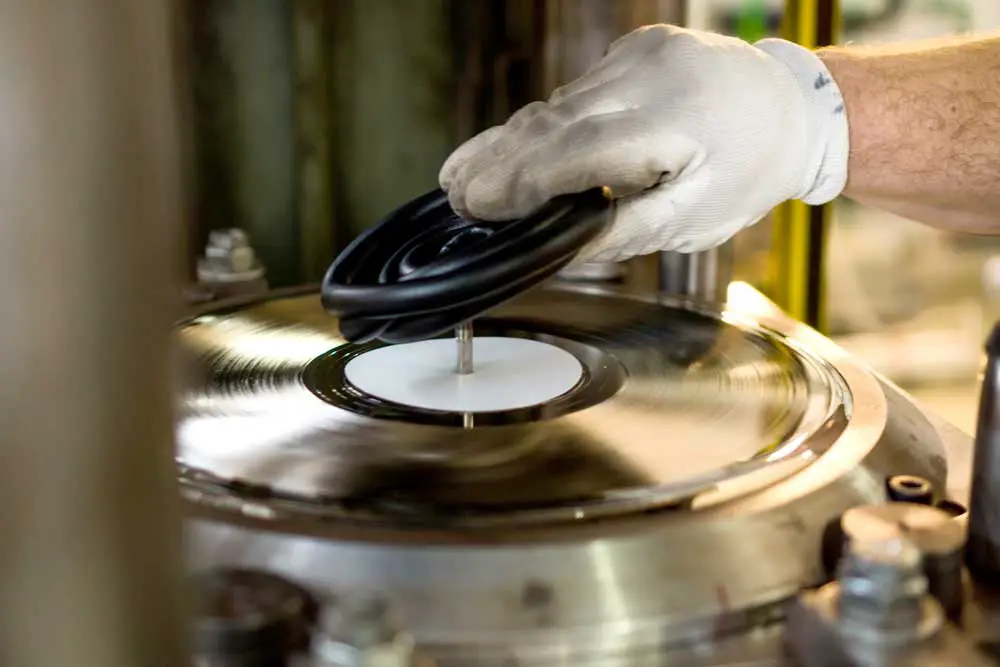

Consumer demand for vinyl records continues to defy all odds in the digital age.
By the end of 2022, total units sold in the US capped out at 43.5 million records (up 4.2% from 41.7 million in 2021—according to this report).
Given that $30-$40 price tags are not uncommon on your average LP, it’s quite remarkable to see such sustained growth in a physical music format.

On top of this, consider that a ten bucks a month Spotify subscription gives you virtually untapped access to decades of music at your fingertips. Incredible…
There’s a lot to consider here, so we’ll break the topics down into a multitude of factors affecting market prices.
At the heart of the issue is simple supply and demand. Consumer demand for vinyl records continues to rise, and quite simply, the current production capacity is struggling to keep up with the thirst for records.
According to this database, there are currently just over 360 known companies involved in the pressing, cutting, or general manufacturing process of making records.

Very few pressing plants worldwide have the capacity to handle very large record runs, and it’s a known fact that typical lead times for production can be anywhere up to nine months from start to completion.
This absurd waiting time has led many smaller companies outside of the major labels to take matters into their own hands and open their own pressing facilities. Most recently, Jack White famously called on major labels to start operating their own pressing facilities once again, having invested his own money to build a facility for Third Man Record.

World events over recent years haven’t exactly helped curtail production times. Back in early 2020, a fire ripped through the Apollo/Transco production facility leaving only one remaining lacquer production factory in the entire world.

For reference, “lacquers” are lacquer-coated aluminium discs used in the mastering process. The mastering engineer will cut the finished recording onto the lacquer, which is then used to create the stamper and start the record production process.
This catestrophic blow to the supply chain of such a fundamental part of vinyl production ripped through the industry, causing shortages, at least in the short term.
The change in circumstances also forced the industry to consider alternative manufacturing methods, such as DMM (Direct Metal Mastering).
DMM was co-developed by Neumann and Teldec. Instead of engraving the groove into a soft lacquer-coated aluminum disc, a DMM lathe engraves the audio signal directly onto a hard metal copper-plated master disk.
Critics often dismiss DMM masters as inferior, but at the industry’s time of need, and with so many livelihoods on the line, alternatives had to be explored while the industry plugged the hole left by Apollo/Transco.
As we all know, 2020 led us into a global crisis of unprecedented lockdowns and the resulting economic impact of inflation that put further pressure on supply chains and labor costs—all of which placed upward pressure on the price of consumer goods.
According to Alchemey at Air Studios Mastering Engineer, Barry Grint even the cost buying supplies has increased over the last year. In a recent conversation with Sound Matters, he explained how this affects his business as a mastering house. “The biggest effect on pricing for mastering is the increase in courier costs”, Barry explains. “The bought costs for Lacquers has increased because of increased freight charges and the shipping of lacquers has also nearly trebled.”
Besides current world affairs, Barry also feels the tendency towards premium reissues means records are costing more than in previous years, stating “I think labels are also delivering better value products, whether it be Half Speed cuts, heavyweight vinyl, or premium booklets and packaging. There are some much cheaper reissues, but they often have poor quality audio, and/or packaging”.
Considering vinyl is a luxury market in today’s digital society, it seems good business sense for labels to focus on premium quality instead of unexceptional and ordinary products to shift in volume.
Some industry pundits position a degree of blame on Record Store Day. Founded in 2008 to help secure the future of independent record stores, the annual event drives countless record collectors to stores searching for special limited edition releases.
While the event does put a positive spotlight on great independent record stores, critics of the event have expressed their frustration around major labels and their tendency to dominate the event with reissues and legacy acts to make a quick buck.
Indie labels and artists simply can’t compete with their buying power, and this puts extra strain on an already stretched production capacity. The result: longer production lead times, higher prices, and less consumer choice…

The price of used records is a separate issue but related, partly due to consumer demand.
Record collectors often mourn the loss of affordable used records and the joy of picking up classic albums at thrift stores for just a few spare notes.
Sadly, as the popularity of vinyl records became common knowledge, the days of cheap charity and thrift store vinyl are long gone.
Stores became savvy to the increasing value of used records, and with online marketplaces, such as Discogs, making it simple and quick to gauge the value of vintage records, real bargains are few and far between.
More often than not, prices are much too high for the condition of the records as many stores or resellers are at best naive when it comes to grading used records.
The ever-rising cost of vinyl records is a multifaceted problem. Any market where supply can’t meet demand will inevitably see higher prices at the cash register.
Supply chain issues, corporate behaviour, and world events naturally compound the issue, but many of these problems can be fixed by increasing production capacity.
We are seeing a growth in pressing facilities, which is great news, but with the increase in demand showing no signs of stopping, it’ll be some time yet before capacity reaches a point where competition leads to falling prices.
Vinyl remains a niche interest, albeit with impressive growth. For this growth to sustain, there’s no doubt the price needs to come down.
Under the right set of circumstances, digital streaming and physical music formats can offer us the best of both worlds. Arguably the growing popularity of vinyl owes much of its success to its unique position as an antidote to increased digitization. Like yin and yang, there’s much to be said for one needing the other in pursuit of balance.
Marc is the owner of Sound Matters and a musician with a BSc Honours Degree in Music Technology. His love for records grew in the fallout from digital downloads and a feeling that, somehow, without the physical medium, the magic was lost.